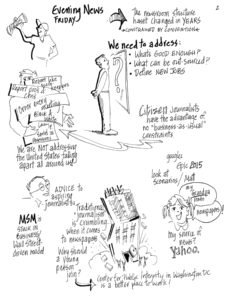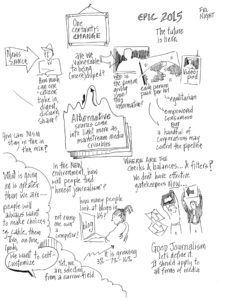
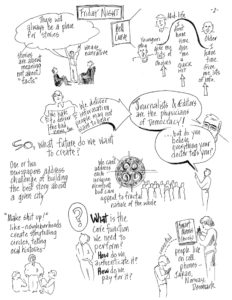
Continuation of the discussion on potential sustainable economic models for various media
CONVENOR: Lisa Cohen
PARTICIPANTS: Ken Berents, Cindy Zehnder, Lew Friedland, Nora Paul
Discussion
Ken is concerned that citizen journalism doesn’t provide for a gatekeeper and gatekeepers are necessary.
For 40 years profits steadily increased for the broadcast owners, but with the economic pressures today, he believes broadcast companies would be better off if they were private. He also thinks cross-ownership should be allowed because it can allow more profitability. He says public broadcast companies are expected to have the same profit margin as all other publicly-held companies, which puts a strain on the amount of money actually allocated for newsrooms.
Television news takes the easiest way out right now… covers the easiest no-brainer stories and don’t make any attempt to do more in-depth because it’s too time-consuming given the needs for feeding the beast with 24-hour news.
Ken says duopolies are very profitable.
Cindy suggests finding a successful way to connect with people will lead to profits. Is there a way that the product can drive the profit? For example, the Google model.
Walled Garden vs. NYT approach for extra profits.
Wall Street Journal uses the “walled garden” approach…charge everyone to use any part. That leads to a finite number of subscribers. The New York Times is using a different approach but offering 95% of its paper online for free, but just now is beginning to charge for access to its columnists and its archives. Archives are a great source of revenue.
Lew asks still “Who is covering the school board” How do we make money enough to cover local news? It’s valuable in the aggregate, but not in the disaggregate.
Ken looks at Weekly looking at local news issues … profit is 15% as opposed to dailies who’s profit is closer to 30-pecent or higher. So there is an approach that is possible if we are willing to accept a lower profit margin.
Lew talked about the Commons Model” he is creating to train citizen reporters in the basics of journalism so they can collaborate with local papers and, possibly, other mediums. It is currently grant-supported, though that’s not what he envisions in the future. This is not blogging, the student journalist must learn to report accurately. This can take objective cost-effective journalism down to the local level. They’re trying to carve out space be creating a city news model… citizen journalists pitch stories to city desk at local newspapers and can possibly follow up by providing more research or even reporting. He is still determining whether you can create something of value for journalists with this model, and is still working out the revenue model.
Ken doesn’t like the gifting model because it ebbs and flows according to the economy.
Cindy — for TVW, legislature hasn’t cut funding yet, even in tough economic times. They’re trying to diversify –getting a few private contributions. They’re beginning to increase their revenue with underwriting by large companies with stakes in public awareness, i.e. Boeing, Microsoft, etc. They’re beginning draw underwriting to new edited programs, though these don’t involve “reporting” in any sense.
Lew is concerned that sponsors will slant the programs editorially which can crowd out true reporting.
The Commons model has to be a rigorous training model –University center training—that would possibly charge papers and/or other media to have access to the story ideas and research. It also stimulates more interest in the model by building relationships with reporters.
Lew is also developing a civic mapping system, a software model that maps community networks of social pathways. It extracts content about “who’s working with whom… audits, reporting, and community leaders. It’s designed to be combined with traditional reporting as a tool to enhance and deepen storytelling. He hopes this model could help build an appetite for public journalism.
It’s designed to curb the negative impacts of high newsroom turnover. A huge issue as older people leave and institutional memory is lost. It also can be a valuable reader/watcher tool… leading to a virtuous cycle rather a vicious cycle.
Cindy is trying to effect and enable direct representative democracy as TVW moves to the second generation of Public Affairs programming.
Lew suggests there are two possible newspaper models…
- Sell subscriptions to people who can afford it.
- Keep publications partially subsidized
How do we reconcile what’s interesting to the public with what’s in the public interest?
Convener: Melinda Wittstock/Jan Schaffer
Participants: Linda, Jonathan, Matt, ?, Lisa, Sarah, Stacy, Silja, Karen, Diane, Ken, Cindy, Ralph, Sarah, Florangela, ?
Reporter: Florangela
Discussion 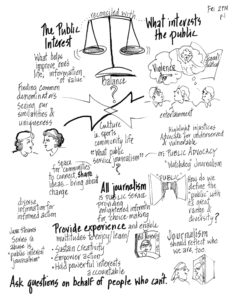
“The highest traffic websites are porn sites.
“Look at the appeal of sports.
“Prurient news vs. what is valuable
“I’d argue sports is just as important. It’s part of our culture. It’s what makes us a community.
“When we get into trouble is when valuable information gets left out and it’s just entertainment.
Question: What is public service journalism???
- Journalism that helps us see ourselves as human; to see our uniqueness and our similarities with one another. We need to know we’re not alone. Journalism that helps stitch the culture together. Sometimes we’re just holding a mirror to ourselves.
- It’s creating a space for communities to work. It’s giving them information, giving them a way to exchange ideas. It also serves as a watchdog, cultivating fairness and justice.
- Our job is to provide information for residents. To allow as many people as possible to participate in civil society.
- Providing a diverse amount of information for informed action
- It highlights injustices.
- The term “public” is way too broad.
- We can’t commit journalism from on high.
- All journalism is public service. Providing information that helps us to make decisions. It’s broad, deep, has depth.
- Provides a window into civic life. IE giving access to public events.
- It supports and sustains creativity and culture in communities in which it operates. It empowers audiences and it does hold powerful interests accountable.
- Look at the work done by Jane Elle Stevens (at the San Jose Mercury News). Look at how the paper reported on individual instances of domestic violence. And then it pulled back, looking at the overall problem. It wasn’t just routine crime reporting. It became a public service
- We are charged with asking questions on behalf of people who can’t, who don’t have that access
- Transparency. Shining light into dark corners.
Question: Does public service/public interest journalism have to be cod liver? (dry, boring).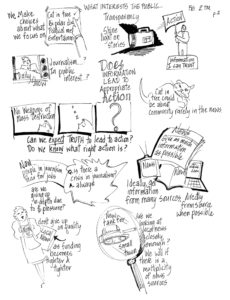
There’s an assumption that if we give people the information that they’ll do the right thing. But I’m not sure that’s always the case. (WMD, Iraq war)
People hear what they want to hear and they see what they want to see.
Do we do things for the outcome?
The best way to approach truth is to have as much information as possible.
There needs to be a forum where all ideas can be debated and really, that is way more important than a specific outcome.
I would hate to lose an institution that gives out good information.
Watch a speech on TV and then read all the news sources and compare how they interpreted it.
Individuals now have a multitude of sources. We should remember that access to C-Span, etc came about because of public policy decisions.
You can do a story that’s well, that’s captivating, interesting and relative.
Is there a crisis in Journalism? I’d say yes. And No. Some of these same questions were being asked in the ‘70s.
It’s the profession: we’re always critical, we always have two halves to every story. But I’d argue that morale is worse today. People are worried about their livelihood.
Question: Why is news focused on process of politics instead of the issues.
How do you create a demand for that stuff?
A key is to reverse the drive towards ownership consolidation. (And look at how the media wasn’t even covering that subject). Bigger corporations have increased economic pressures and are more distant from the communities they cover.
Is public interest journalism ratings-adverse?
You gotta have the bottom line because otherwise you won’t have the newspaper/station, etc.
I’ve never had someone dictate what I could/could not cover.
Financial pressures retard good journalism.
There’s no One public.
Beat reporters are very process driven but our whole structure of journalism is to document incrementally.
Journalism needs to be much quicker to connect the dots, to give context of a story.
Be aware of where the public interest is and contextualize it.
But ability to think in a larger way (different entry points, different way to cover a story, an issue, etc), is constrained by production deadlines.
Healthy Journalists/ What does a day in the life of a healthy journalism organization look and feel like??
Convener: Jane Elle Stevens
Reporter: Florangela Davila
Participants: Dan Gillmor, Eric Nelson, Stephen Silha, Linda Grdina, Florangela Davila
Discussion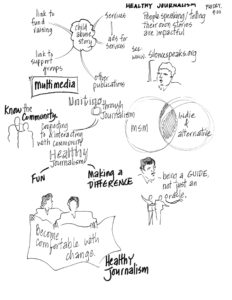
“News orgs. aren’t connected/aware of the community/public.
“So how does a community become part of the journalism organization?
“Calls to a newsroom from the public don’t even/always get answered.
“What about an ombudsman?
“News orgs. are too motivated by the bottom line. Can we persuade management to accept lower profit margins??
“Yes. Look at something like the Center for Public Integrity that’s doing investigative work and is non-profit funded.
“Look at the Lawrence World Journal.
“High profits don’t necessarily translate into good journalism.
(But money matters).
“The reality: It’s a lot more fun to be part of something that’s growing vs, something that’s breaking.
“Look at the pay of journalists. They can’t even live and function in the city/ies they cover.
“News org. talk about their “readers.” But ‘readers’ doesn’t necessarily translate into The Community.
“What is a healthy organization? Is academia healthier?
No. J Schools might as well be microcosms of traditional newsrooms.
“A colleague once said: Journalists are all insecure and they all want to have fun and make a difference.
“What about nurturing one another? Finding people who share your spirit/mission/goals. Cultivate “healthy pods” in the newsroom. Maybe that’s how an individual journalist might grow.
“The only resource we have might be each other.
“Until there’s a culture or acceptance of taking a risk nothing is going to change (in news orgs).
“Look at Silicon Valley where if you fail and you fail well, it’s still attractive.
“Look at how Silicon Valley has incorporated/accepted Change as part of its culture.
“There’s no Research and Development in newspapers.
“There’s no risk taking.
“Look at what’s happening at the Oakland Tribune. We took 14 people and we’ve changed it into a webcentric newsroom. Journalists are taking cameras out, which forces them to get out of the newsroom, to talk to people face to face. It’s like a bolt of electricity. They’re out there now and they’re engaged.
“You can still have depth in multimedia.
“I don’t believe journalists need to be bloggers but the community needs to be bloggers.
“Newspapers are still reluctant to point to elsewhere (link to other websites).
“Look at BBC. They link to everything.
“Look at how there’s a divide: alternative media vs. indie vs. mainstream.
There ought to be something uniting everyone. We all have a common purpose.
“Print and TV has been problem oriented.
Look at the Internet: It’s solution oriented.
“Journalism is a guide, not just an oracle.
“A new model to explore: mass media going hyper-local, largely written by the community. It could be a good business model. You could give people some training. Give community the tools by which it can cover itself.
What’s the bridge to these solutions? The journalist, I think.
Citizen Journalism
Convener: Eric Nelson & Linda Grdina
Participants: Dan, Sue Ellen, Jan, Jean, Lew, Stephen, Dale
Discussion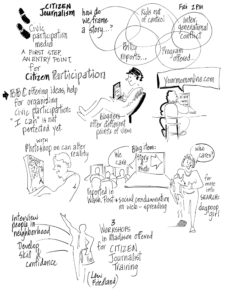
Questions:
What is required to pilot a dialogic and deliberative from of citizen journalism?
How does new media build and sustain community?
How does citizen journalism prompt community action?
Discussion Notes
There are thousands of citizen journalism experiments in progress in the U.S..
Therefore we need to track what is being learned and use this to develop new models.
Everyday citizens state that no one in mainstream media is covering the issues of
the common person on the street and want a mechanism for share and learning about
this news.
What do we mean by the word community that is used in the questions for this
conversation? There are many sub-communities but is there one community?
How do we really know if citizens want citizen journalist?
Anecdotal evidence shows the citizen journalism has increase citizen engagement on
issues, facilitates development of new social networks, and supports two-way
communication between citizens both on-line and face-to-face.
Editors can provide a critical role in maintaining credibility and quality of
citizen submitted stories but does this homogenize the approach to reporting.
It is important to monitor what is emerging naturally from various social networks
and how they are using processes and technologies to support and grow their
networks. Based on what is emerging, new models of citizen journalism we could
development.
Citizen journalists will their stories in unique ways that are unlikely to replicate
tradition journalism styles. The web and it capacity for linking and two-way
communication will form citizen journalism in unique ways.
Citizen journalism increases citizen involvement and understanding of the complexity
of issues, even if people are reporting from an advocacy position.
What is the role of the citizen journalist in convening or facilitation public
discourse?
Will citizen media become a new form of civic engagement?
Can there be a role for journalist and new organization to create the
container/infrastructure to enables citizens to share concerns, tap critical
information, and solicit public discourse on areas of interest, concern, hope? What
would such an infrastructure look like and who would maintain it?
How do social networks use computer networks?
Is it possible to support online discussion between advocacy groups?
J-Lab grant to Madison. Using a web site, they’ll form a broader common space for
community discussion, informed by reporting, not blogging. They did an open call for
“journalism 101” workshops ($35/workshop) to train people to be citizen
journalists. Issues they focus on will bubble up from reporter interaction in the
community, not online forums. Phase two or three of this work will include convening
community conversations.
Once you train citizens to be journalists do you homogenize their approach to
reporting?
There are models, like J-Lab, that create entry points from citizen journalism and
other models that wait for entry points to emerge organically. This area is still
forming; it’s too early to evaluate the impact of citizen journalism.
Book: Smart Mobs, Howard Rheingold
Web Sites: BBC Act Now – provides tools for people to take action and informs
journalists about what people are interested in so they can cover those topics/areas
of interest.
What can the elders in journalism and the newcomers in journalism learn from one another?
CONVENOR: Chris Peck
PARRTICIPANT LIST: Chris Peck, Bill Krasean, Sarah Stuteville, Ken Sands, Matt Thompson, Duane Stoltzfus, Florangela Davila, Silja Talvi.
DISCUSSION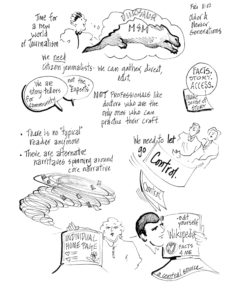
Chris Peck: So, what’s different about the journalism expectations and practices of those who have been in the business a long time, and the expectations and practices of those who are new to the business?
Matt Thompson – Well, for my generation (younger Gen Y) there is an expectation that we can get the news on our terms, where we want it when we want it, not just once a day from a newspaper or a broadcast TV site.
Sarah Stuteville – I don’t think the difference is that young people don’t care about the news and older people do. But I do think that young people think the old news, and old media, are dinosaurs. The newspaper seems old.
Ken Sands – And, I think young people sometimes read the newspaper and feel stupid. They haven’t been following things day-to-day, so they pick up the paper and start reading and can’t follow stuff. Online, they can go, find out the background, the context, and they can feel smart.
Duane Stoltzfus – I think some people are tired of the news driving people apart, instead of bringing people together. It’s very one –way. For a new generation of journalists, I think that there has to be more of an effort to make a connection with people.
Sarah Stuteville – I’m thinking of the recent series in The New York Times about Class in America. It’s got context. It is a series that helps me understand the big picture. I think my generation will read that.
Matt Thompson – The biggest frustration I have with the older generation of media is looking at the Web sites. They represent an utter failure of imagination. I think the digital media world give us an opportunity to offer a variety of perspectives, many points of entry to a story. But newspaper Web sites continue to just stories from the newspaper. There is no serendipity in newspaper Web sites, no way to make connections, link one idea with another.
Ken Sands – One of the mistakes that today’s journalists make is thinking that once a story appears in the paper that’s the end of it, that’s the end of the story. Online, we know that people come in waves to explore, to learn. They go back to read stories, find the whole pictures.
Chris Peck – And, we often keep telling the same incremental story, again and again. The War in Iraq becomes one story after another about how many soldiers or civilians were killed today. The eyes of our readers begin to glaze over, even though we need to be connecting the dots between the war, our reliance on oil, our politics, etc.
Ken Sands – People want something new every day. An example: in Spokane we ran a page one story on the Iraqi constitution last week and got 20 hits. On that same day we ran a story about local policemen who stopped a drunken 19-year-old girl as see was speeding at 90 miles an hour through a school zone. He didn’t ticket her because she agreed to have sex with him. That story got 50 times the readership. People already had heard about Iraq, they were more interested in something new.
Sarah Stuteville – I agree, there are stories that people don’t want to read because it just seems like the same old negative stuff day after day. Sometimes I think people of my generation just want the media to give the negativity a rest. I find myself going to worldchanging.com, which is all about people who are making a difference around the world. My generation wants to know about people who are doing amazing things, but there is not much in the mainstream media that tells about these things.
Matt Thompson – And, many young people get their news and politics from entertainment and culture. From music and movies they decide what they care about, that’s what the news is. When Green Day sings American Idiot, for many people that’s enough of politics – through arts and entertainment.
Chris Peck – I think what this suggests is that much news is now a commodity. Think of Harriett Meirs, the Supreme Court nominee. Two weeks ago, no one knew her. Today, everyone knows a little bit about her. So what becomes interesting are the different takes on here, from The Daily Show, or blogs, or other sources outside the mainstream media.
Matt Thompson – Young people are very savvy at getting the nut of information these days. We know the basics. What is interesting to us finding out how others are responding to the news, challenging the master narratives, going against the grain. These alternatives narratives can be funny, absurd, angry, off-the wall. But they need to be included in the future practices of journalism.
Ken Sands – For the next generation, the readers really are in control of content, and the traditional journalists don’t like it. They want to be the keepers of the news, control the flow of the news, and be the gatekeepers. And, when they see that begin to slip away they get scared. They don’t want to change.
Matt Thompson – The idea of a central journalistic authority playing to a common denominator is gone. An example: Wikipedia has replaced The New York Times as the newspaper of record in this country.
Chris Peck – So, we need to find a way to get more voices, more varied perspectives into the coverage of news and in the very definition of news.
Faith-Based Media vs. Fact-based media / Advocacy journalism
Convener: Dan Gillmor/Jonathan Lawson
Reporter: Jonathan Lawson
Participants:
Dan Gillmor, Jean Min, Karen Toering, Jane Stevens, Sue Ellen Christian, Jonathan Lawson…
Discussion:
Framing comments/questions:
Dan: Much contemporary journalism (Fox news may be the most prominent example) presents “faith-based” journalism, in which reportage complies with established pieties. For good journalism, facts must be the fundamental, not faith.
Advocacy journalism is useful, but there is a danger that journalism advocating for a particular point of view may overstate (or ignore) facts that help support an argument, while leaving out other relevant perspectives.
A terrifying statistic emerges from a PIPA study a couple of years ago that demonstrated that a large percentage of people who get most of their news from Fox News believed that Saddam Hussein was responsible for the 911 tragedy and that weapons of mass destruction had been discovered in Iraq. How can we get people to distinguish between faith-based and fact-based journalism?
Jonathan: Fox News is an example of what is actually the dominant form of advocacy journalism—advocacy for the political and economic interests of the wealthy and powerful. Now that citizen faith-based reporting seems to be on the rise, helping produce more fragmented audiences, is there a positive benefit for “advocacy journalists” to develop something like professional standards upholding the pursuit of truth and (elusive) objectivity, while at the same time being self-conscious advocates for democratic values?
Discussion
Can journalists be political citizens? Sometimes, at least, no… policies against attending demonstrations, etc. There is a reasonable distinction to be made… if someone’s beat involves covering an election, that reporter perhaps shouldn’t attend a demonstration against a candidate. A legitimate concern.
Can you combine journalism and advocacy? Sy Hersh, Ida Tarbell and the whole tradition of muckrakers would say yes.
What is the distinction between civic and citizen journalism? Civic journalisms is trying to open journalism to the public’s interests—community advocacy. Created some angst at newspapers; reporters and editors asking: why are we letting the people tell us what to do? Citizen journalism bypasses the newsroom entirely. Citizen journalism also often includes critical engagement with mass media.
JM: As citizen journalism, OhMyNews is open, but also has a distinct editorial focus created by the founder’s intention to provide progressive perspectives. In South Korea, OhMyNews is one of very few media outlets providing an alternative to a monolithic mainstream.
DG: How do we get kids to grow up understanding the difference between straight news and, for example, Jon Stewart’s commentary on The Daily Show?
KT: What is most important to maintain: the daily news core of stories from credible media institutions.
JS: Re. Credibility: The web creates the opportunity for reportage that includes, as sidebar links etc., detailed sourcing and information about stakeholders in a particular story… mapping of key players, opinions, etc.
JL: That in itself doesn’t solve the question of credibility—a highly ideological site could produce its version of such a map as well as a more fair outlet.
The problem to solve is less about the unavailability of reputable information—the Internet provides great access to plenty—than about the perception of mainstream audiences. There was tons of information available online, including from establishment news organizations, demonstrating that no WMDs had been found in Iraq, for example.
DG: There are sites such as sourcewatch, etc. that provide good info on current in-the-news topics. We need smarter readers. Is this primarily a media literacy problem?
We also need laws that require greater transparency about, for example, the funding support for ideological think tanks.
KT: ‘smarter readers make better journalists.’ We do need media literacy.
JM: Today’s media consumers approach media with the expectation that there will be opinion and bias. News outlets need to take sides—make apparent what their political slant is and use that to build an audience.
JL: We need a wide variety of news sources. Google news is useful simply in that it provides quick access to multiple outlets, although it doesn’t do any apparent political/ideological sorting for you.
KT: People often have limited time to consume media—a limited window. For me, I first get the basic stories from balanced, nonideological sources. Later if I have time, I’ll seek out advocacy/opinion sources on the same topics.
SEC: If we agree about what constitutes good journalism, why is there still so much unbalanced reporting?
JL: Part of the reason is the journalistic bad habit of privileging a lazy version of “balance” over truth-seeking. Present two opposing views about, say, global warming, and forego the task of evaluating based on available evidence.
DG: Practically speaking, journalists under deadline aren’t always given the option to go deep.
DG: During the buildup to the Iraq war. Guardian UK web readership spiked—much from US readers hungry for substantive, independent reporting. This fact gives me hope for American media consumers. People can increasingly take advantage of the ability to “roll your own” news report from Internet resources… choose the kind of journalism they want, get substantive reporting from trustworthy sources.
JM: With RSS, readers become their own editors.
JL: But left to their own simple preferences, people won’t necessarilty select what’s best for them, but rather entertainment, sports, ideological news, and whatever the most powerful new corporations spend lots of money to promote. Journalism is a public trust—in order for our culture and democracy to work properly, the public needs to be presented with a level of quality coverage whether they know they want it or not—in fact, good journalism creates the public sphere that enables people to identify valuable journalism in the first place, and understand why it’s important.
JS
DG: A CBS exec recently noted that mass media conditions people to believe that everything is simple, whereas in fact nearly everything is quite complicated. How do we ensure that everyone gets access to that basic daily news report? At the end of drug commercials, you get that quick fine print. We need even basic news reports to explain that there’s fine print, and help people get there.
Is the fun gone?
Convenor: Ralph Gage
Reporter: Matt Thompson
Participants:
Nora Paul
Matt Thompson
Chris Peck
Dale Peskin
Mike Van Buren
Ken Sands
Discussion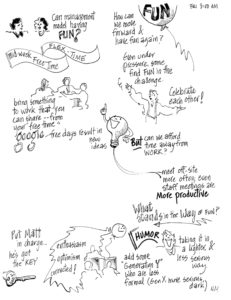
Assume everything below is rough paraphrase.
Question (Ralph Gage): Is the fun gone?
Nora Paul: In some ways, now that convergence is making everyone have to be buddy-buddy and share-and-share-alike, the fun of competition is gone.
Dale Peskin: Outside traditional newsrooms, it seems journalists are all having fun.
Matt Thompson: It feels like everyone’s looking for a template — what story form/new technology/etc. can I replicate in my newsroom?
DP: Organizations like API, with our “best practices” mindset, may perpetuate this.
Chris Peck: As journalists have gotten older, they lose the willingness to experiment with which they entered the field. They start to fear that the techniques and skills they’ve developed over time no longer apply.
NP: The advent of computer-assisted reporting seemed to get people who were willing to try it excited again.
CP: There’s a downer element in many newsrooms. Maybe we need to address those folks?
DP: Journalism is so much about self-worth, which is diminishing across the industry.
CP: Many journalists are convinced their craft actually isn’t that important anymore, that few people are really paying attention. Furthermore, the economic and other pressures within newsrooms are squeezing down even on the young, new journalists.
DP: During Katrina, journalists seemed to be having fun.
NP: It was like after 9/11. Everyone was thinking, ‘Oh, they really need us.’
NP: The early online doomsayers have contributed to the sense of un-fun, telling traditional journalists they’re so out of touch, they’re irrelevant, etc.
Ken Sands: People begin to worry they’re becoming untethered from their values. But maybe the quality they need is the ability to appreciate change.
CP: Maybe the sense of fear that’s squeezing the fun out.
MT: Seems like a lot of wonderful, creative young people aren’t excited by the possibility of journalism. We need more of the dyed-hair, crazy film geeks who are out doing documentaries for pennies a day.
DP: I describe myself as a “recovering journalist.” I’m having a blast right now.
RG: You hear so much about staff cuts and layoffs, it’s really dampening the mood of the industry.
DP: We had a session at the WeMedia conference with Jessica Cohen (of Gawker Media) and some other media professionals. Jessica’s getting like $30k a year and having an awesome time, while these loaded media pros are totally depressed.
RG: Part of what I see is that the folks who are working on the cool new media stuff seem to have fairly regular hours, while the people doing the business of putting a paper out every day are working odd shifts, ruining their social life, being completely unhappy.
CP: That’s a symptom of the culture of the newsroom that needs addressing.
NP: Is the newsroom a maze of cubicles? That’s another symptom and cause of all the depression.
DP: Because of our ‘best practices’ mindset, every fresh new perspective that comes into our newsroom ends up becoming the same stale, old perspective very quickly.
KS: Everything matters less than journalists’ perception (or lack of it) that what they do matters.
CP: You have to talk more about the fact that it does matter. That kind of explicit encouragement makes a difference in the newsroom.
NP: Does having a hyperlinked byline (so people can shoot the reporter an e-mail) help?
CP: It’s hit-or-miss, because people respond unevenly to stories, regardless of the reporter’s effort or passion.
NP (joking): Maybe we should send people e-mails from anonymous fans raving about their stories …
DP: Do you get the sense that mid-level editors are being dumped on?
CP: Yes. While there are personality types who enjoy middle management, a lot of folks in that realm feel dumped-on. Big managers who’ve come up through the ranks from an earlier era get a whiff of these new happenings and ideas, and tell their underlings, ‘Go do something new!’ But these folks have to concern themselves with putting out a paper every day.
KS: We have to make more room in our organizations for even mid-level editors to exercise their creativity.
NP: Not allowing them to be an integral part of our change (even in matters like redesigns) hurts the whole organization.
Michael van Buren: How much of a chill is there from the threat of lawsuits?
DP: The legal aspect is a big question.
CP: And unions, while I appreciate their role, are a big part of it.
RG: Another legal element is the amount of paperwork and bureaucracy needed to do anything. We drown in FOIAs.
MT: Might it just be that our organizations are too big? Too corporate? Part of my sense of fun comes from the perception that I’m part of a small, scrappy team, fighting together for a common cause. Should we need mid-level editors?
NP: I remember when editors used to lunge at reporters in the newsroom. There was passion and anger and messiness. Is there something about that mess we miss?
RG: So is the fun gone?
CP: In many, perhaps most, places — yes.
DP: Maybe it’s time to go back home and start asking that question in our organizations.
KS: I’m having more fun than I ever did. But this is a rare thing. I’m not sure how many people are able to embrace creativity and innovation. They find those things scary.
MVB: Yep, the fun’s gone.
MT: What was it like when everything was fun?
DP: We’ve sort of got a selective memory of that time.
NP: There were a lot of zany, idiosyncratic characters. Maybe for me it was even a nostalgia for that ’40s-era style.
DP: But I also remember characters who were tyrants, sexists and drunks.
CP: It might be that we just plain need an infusion of new people. People who are at that early, experimental stage in their careers. You have to work at getting them. Then you have to celebrate those experimental moments when they do come. If you’re going to frame and highlight something, highlight those awesome moments.
DP: In the military, they call it, “One ‘attaboy,’ for every five ‘aw shits.'”
MT: So how do we get that infusion of new people?
CP: Hire them. Bring ’em in through new media. Bring ’em in through citizen journalism. Just hire them.
NP: Then give them actual room to work their magic.
CP: It’s not just youth. Many old-line journalists are also seeking change. Find them too! Find these ‘fun nodules,’ the elements who will inspire creativity and enjoyment, and put them in key places around your organization.
RG: Let’s bring it back. When we leave here, we’ll go back to our organizations and ask, “Is it fun?” If the answer’s no, we’ll ask, “When was it fun?”
CP: There’s a danger in “going back,” in reminiscing about the days when. We need to explore forward.
RG: Ken, why are you having fun?
KS: A lot of it is your perspective. We need to begin appreciate the moments and possibilities for change in our own careers.
MVB: Management often sets that tone.
DP: This is bigger than management, though. It’s culture, how people related to each other, their work, and more.
NP: If managers want to create a learning organization, they need to keep learning themselves. They need to go out and play golf.
MT: Could we try thinking small? Of course, we imagine ourselves being soooo big, we’ve got aaaall these responsibilities, we’re stretched to the limits. But somehow, giant Google is able to give every employee a day a week to just indulge her own passions.
DP: Yep, but part of the deal is they have to bring something back. Some companies offer flex time, which is literally time to be inspired whichever way works for you. Take a walk if you need to.
CP: There’s something to that idea.
KS: You also have to create an organization where people feel that freedom organically. That’s what Chris did. But people are going to resist that, because of the pride they feel in their work, and their sense of constant need to do, do, do.
DP: At the Media Center, we have a policy of no meetings inside the building, to get a regular shift in perspective and tone.
KS: Again, part of this is in having fun yourself.
Nancy Margulies: What are ways we can help people have fun?
CP: There’s this whole stiff atmosphere about news organizations we just need to puncture sometimes. Make jokes.
NP: That’s the role of those idiosyncratic characters. Does your newsroom have any, Chris?
CP: We have some. But some of them are throwbacks. We maybe need some new characters.
DP: Sociology has looked into this from a generational perspective. Something about Generation X, the folks who are now mid-level managers in a lot of our organizations, they’re just kind of depressive, as a group. Gen-Yers, the youngest generation in most of our companies, are for whatever reason optimistic, creative, appreciative of change.
CP: Could we have some fun around that tension? Even dark humor.
DP: There are a lot of these folks out there. It’s a matter of finding some sparks. I’m optimistic.
CP: We need to find an alternative to some of the big, traditional journalism organizations. The mentalities plaguing our newsrooms have gotten ingrown there. We do need to find sparks, then nurture them where they exist.
MT: At the Fresno Bee, I had the good fortune of heading up a committee of young folks from in and out of the newsroom, these sparks with outstanding ideas who were thriving in an unlikely place.
DP: One of the questions we’d ask some groups of newspaper readers was, ‘If the newspaper was a celebrity, who would it be?’ The folks from the newspaper always wanted to hear they were Tom Hanks. But what every single group would answer, in meeting after meeting, was “Walter Matthau.” Either him or Walter Cronkite.
What Are Commons Models? How they can be built and sustained?
Exploring economic models capable of sustaining and growing relevant journalism?
Convened by:
Lew Friedland Friday 9:30am
Notes:
Sarah Stuteville
Participants
Karen Toering
Jean Min
Ken Berents
Jan Schaffer
Lisa Cohen
Jonathon Lawson
Jarah Euston
Sarah Stuteville
Stacy Lynch
Sue Ellen Christian
Bill Krasean
Lew Friedland
Melinda Wittstock
Cindy Zehnder
Stephen Silha
Peggy Holman
Discussion 
Jan-
Jimmy Wales of Wikipedia commented he’s organized as a non-profit but now has revenues, though it’s all citizen content. Someone like him Entered the arena with no aspirations for an economic model, but one has emerged.
Lisa-
Maybe we should take a vote and see if people want to keep these two topics together?
Melinda-
Commons models are a subset of larger economic issue.
If you have an idea do you throw it on the wall and see if it sticks, or figure out the economic stuff first?
Linda-
What eco models are people familiar with?
Jean-
What is the real value of journalism? What are people willing to pay for? How do we figure that out? How do you put a price on this stuff?
Ken-
Psychic income
Jean-
Isn’t journalism rewarding enough? Or is it? What about fame?
Lew-
There is the economy of time and attention that readers/citizens can invest in your media. They give you time and attention which is something.
(Someone asks how Jean how OhmyNews supports itself)
Jean-
OhmyNews is 40% ad supported, 20% wire service type sales
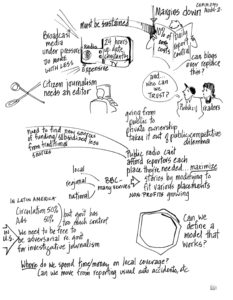 Stacy-
Stacy-
I spent a lot of time on profit and loss statements, on all this stuff. I can do the nitty gritty of this stuff. I think that finding a sustainable model for commons sites is an easier question than how we can do that for more traditional journalism. Commons models are so much less expensive. The single biggest cost for papers is newsprint (20%), than payroll(20%) (and 20% of that payroll is for the newsroom). The cost of subscriptions only pays for the print paper, we spend 20% selling it. There’s a lot of mechanics that goes with it.
80% is advertising. Within that a lot is classifieds. This is why the commons models are killing old papers. They can’t charge for listings anymore. How can we think of cheap less expensive ways to do the basic nitty ritty fact finding that every community needs?
You need 30 reporters on local politics. Citizen journalists can’t be counted on to do the less glamorous stuff like school districts, and local politics–the hard, time intensive stuff.
Ken-
Citizen journalists may not have the same access, lawsuits, ability to make requests for information. Citizen journalists can’t do that.
Jarah-
News orgs should wean their readers off of print
Ken-
This is a generational issue. Newspapers should be more expensive.
Stacy-
If we could just get rid of print, it would be easier. But the number one hurdle is that print is a more effective ad medium. Ad inserts are big. It is not as attractive on web.
Somebody-
Advertisers can direct mail.
Stacy—too expensive
Melinda—What drives circulation? How much does it have to do with journalistic content and quality? How much can journalists do to increase circulations of their papers?
Stacy—In the research we do about our readers 70% want good content. The people that really make this work are the subscribers.
Lew—Young people don’t read papers anymore, they read on-line. They may have the habit of reading a paper but just don’t want it in print. I think this will continue to happen– exponentially.
(Stacy)—Advertisers don’t get results with ads on the web because they just don’t work, people have learned how to ignore them
(Lew)—Part of the heart of this discussion is the cost of the daily report (20% for payroll 20% of that which goes to the newsroom). For those that care about journalism, the daily report is the heart of what makes journalism work. Sustaining that report economically is so important. If we lose that daily report the commons models can’t fill in the need.
(Somebody)–Can they?
(Lew)–For me the argument about economic sustainability is essentially about economically sustaining the daily report.
Commons models alone (I’m building one in Madison) cannot sustain the daily report. They will never pay for the level of professionalism that we have come to expect.
(Linda)—What about broadcast the new requirements to have this stuff on 24 hrs a day? The owners expect huge profit margins from us. What we see is that the quality has decreased and we’re using fewer people with less experience. Now you have to cover on LMA plus your regular station. You’re covering for too many entities at once. We need full time experienced journalists that are trained.
(Ken– you need an editor, citizen journalists don’t have that.
(Melinda)—one of the reasons public trust has eroding in part is because nobody knows who to trust because there are so many sources and so much information out there. Truth has gotten lost in that. The more we get cut back economically the more we have to count on Citizen Journalists. It’s a flowering of democracy to a point. But how good is it?
(Ken)–I have a solution, I follow these companies closely. The margins are going down and will get worse. These companies should go private. When you are a public company you have to compete with everyone.
(Jonathan)—What is the big picture? What is the role of media in our society? How does it help make our civic society work? Having a business model where the primary driving of the news organization is to maximize shareholder value may be able to coexist with good journalism, but it may not, and actually it probably won’t.
(Jean)—What about BBC?
(Everyone Talking)—Different culture! Different eco model!
(Melinda)—BBC is a non-profit, if you buy T.V. that money goes to a common fund and some gets directed to them. Capitol New Connection has found a way to get around this. Public radio would all have correspondents on Capitol Hill if they could afford it. CNC works by being hard nosed and productive, its reporters think about how they can maximize a story. It is affordable to public radio, they get their own correspond on Capitol Hill. It is an economy of scale. Reporters are paid between 45-55 thousand a year. As we grow their pay grows.
Non-profit news. This is a trend.
(Ken)—BBC tax model v. revenue model
(Melinda)—Everyone in public radio is trying to diversify revenue models.
(Karen)—The difference between non-profit and revenue is the difference between re-investment in the company vs. divvying it out to shareholders.
(Bill)—Has anybody looked at bottom line between public and private models?
(Cindy)—One thing to be careful about is trying to define “A Model” that works. One of the good things coming out of all of this is finding a number of models that work. There are many ways to get at all of this. Listening to the different possible models may help find something new. Maybe there isn’t one new model that we can find that will offer us the security we want. Maybe we should bundle models.
(Jonathan)—Multiplicity of models. Public media has a pressure to diversify fund sources. This is an opportunity to think about moving the other way. We should increase and celebrate public subsidies for media. Every broadcast company is hugely subsidized. Postage used to be subsidized. Why can’t news be so too (print)?
(Stacy)—I want to counter argue that. In Latin America they don’t have the advertising base. In many ways they all started off in highly subsidized situation. But they are highly controlled by the government. Their number one advertiser is the government. and if they pull their ad because they don’t like what is being printed they can destroy papers.
(Cindy)—I am government. subsidized. 80% of our operational funds come from state funds. We are also governed by an independent board of directors. I am acutely aware that what we do is not the kind of investigative journalism that would be too challenging to local government. You would not see us suing local legislature for information. We want to be wholesaler and retailer for other organizationss (getting out good info).
(Linda)—The critical thing to me is that there are many ways we can get our national and international news. We can’t outsource local though. As I watch and read our news, it seems to me we have gotten off track, as far as content. It’s like a crow looking at the shiniest thing and following it around. Is there a desire for a new thoughtful newscast? The market share is decreasing and all of the stations are going for a tiny piece of the pie.
(Jan)—You build your model on trust in the community. How do you leverage your trust in the community with other things that are of value. (target info, target ads)
(Ken)—target ads that’s were everyone is going.
(Jarah)—Wouldn’t it be great if your news source targeted ads to you as well?
(Jan)—Can you monetize an affinity group (the way blogs are affinity groups)
(Lew)—There is no way that you can monetize trust around something like the local school board. No one will pay me to cover the local school board. Here’s the problem, what broadcasters are doing, they used to have State Capitol correspondents now they’ve dropped them. Now papers are dropping them so they can rely on state spans, but everyone here is talking about how state spans are limited in what they cover (see Cindy’s comment from earlier).
(Lew)—small local papers are being set up to cover their communities. That’s what is happening.
(Stacy)—Advertisers aren’t the only problem here, there are many ways that advertiser can continue to be the primary funders. Advertising is not the root of the direction journalism is going.
(Lisa)—Maybe we can set something up so that advertisers understand or see how supporting high quality reporting is in their interest.
(Cindy)—People need and want to info, (even if trust is low). I want to throw out another model, KEXP, Paul Allen supported radio station. They want to create a tribe around the music experience that they show and create. The music is just stream, there is concerts and all kinds of things they do. They are building an affinity group around the music experience.
(Lew)—translate that to journalism
(Cindy)—people that are tied to certain concept journalism might be willing to pay for it. I want to organize people so that if they want to look for quality reporting. Starbucks model, people that pull together around the Starbucks experience, music, etc.
(Jarah)—Starbucks hasn’t been that successful with that
(Stacy)—People would have to pay like $600 a year to subscribe to a good paper is we get to the point where readers pay for all this themselves.
(Melinda)—Local coverage with NPR. Morning edition audience nationally is huge. And it’s a huge audience that advertisers want to reach.
(Lew)—There is only a very small niche of people that want NPR. What about wi-fi? I’ in S.C. and it’s a wi-fi as soon as you turn your computer on the first thing you see is the website of the local paper. Google announced that they are giving out wi-fi free. Basic level will be free and then you pay up for the other levels (like cable). What about Times Select? They only restrict 2% of their content. (Columnists Friedman) and archives, but people will pay for that stuff and you can increase revenue. Broadcast could do this too.
(Cindy)—The distinction between all of these mediums is beginning to go away. Think about convergence (not just print, broadcast, radio, etc)
Point of clarification on the Goodgle Wi-Fi deal
(Lew) the way this works. A company just signed up to put wi-fi all up
Supporting media without advertising?
(Karen)—We need a low barrier for participation in this information. I am concerned with levels and qualities of information for the haves and the have nots. I really can’t see this


